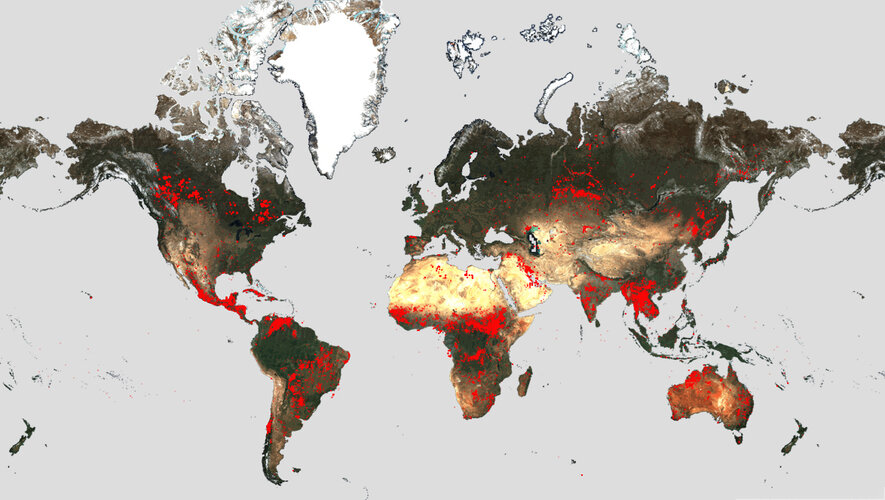
Copernical Team
Recycling parts for life on the Moon
 Image:
Recycling parts for life on the Moon
Image:
Recycling parts for life on the Moon Simulating Aeolus’s demise: a bird’s eye view
 Video:
00:01:35
Video:
00:01:35
Aeolus’s mission is over, but weather forecasting is improved forever, and a new precedent has been set for safe satellite reentries. The trailblazing Earth Explorer returned through our atmosphere on 28 July, following the path it was guided on by ESA’s mission control over Earth’s most uninhabited regions, finally disintegrating over the Antarctic.
A week-long series of manoeuvres led to this point. They had never been performed before and pushed the satellite to its limits. Aeolus was never designed to fly at such low altitudes – its thrusters and fuel reserves were
Counting wildfires across the globe

In recent weeks, devastating wildfires have spread in Greece, Italy, Spain, Portugal, Algeria, Tunisia and Canada, causing human casualties as well as massive environmental and economic damage.
While wildfires are a natural part of many ecosystems, scientists have warned that they are becoming more frequent and more widespread. In response, an upgraded version of ESA’s World Fire Atlas is now available providing a detailed analysis of wildfires across the globe.
Sunlight peaks drove Ice Age's abrupt climate shifts, suggests study
 A comprehensive research endeavor led by Heidelberg University and the GFZ German Research Centre for Geosciences Potsdam has shed new light on the causes of abrupt climate changes in ice ages. The study suggests that variations in summer insolation, or the amount of sunlight received, played a vital role in steering the shift between warm and cold phases during past ice ages.
The collabor
A comprehensive research endeavor led by Heidelberg University and the GFZ German Research Centre for Geosciences Potsdam has shed new light on the causes of abrupt climate changes in ice ages. The study suggests that variations in summer insolation, or the amount of sunlight received, played a vital role in steering the shift between warm and cold phases during past ice ages.
The collabor Shenzhou 15 crew share memorable moments from Tiangong Station mission
 The three astronauts from China's Shenzhou XV manned mission met with the press on Monday, in their first public appearance since returning to Earth 57 days ago.
Mission commander Major General Fei Junlong, Senior Colonel Deng Qingming and Senior Colonel Zhang Lu have completed quarantine and recuperation, the first two stages in their period of recovery after landing, and are currently in
The three astronauts from China's Shenzhou XV manned mission met with the press on Monday, in their first public appearance since returning to Earth 57 days ago.
Mission commander Major General Fei Junlong, Senior Colonel Deng Qingming and Senior Colonel Zhang Lu have completed quarantine and recuperation, the first two stages in their period of recovery after landing, and are currently in Lunar Regolith to Power Moon Bases: Blue Origin Gets NASA Backing
 Blue Origin, the American aerospace manufacturer, is moving a step closer to making its innovative concept of generating solar power on the Moon a reality. This follows the receipt of a $35 million Tipping Point partnership awarded by NASA to continue developing its revolutionary technology known as the Blue Alchemist.
First revealed earlier this year, Blue Alchemist aims to produce solar
Blue Origin, the American aerospace manufacturer, is moving a step closer to making its innovative concept of generating solar power on the Moon a reality. This follows the receipt of a $35 million Tipping Point partnership awarded by NASA to continue developing its revolutionary technology known as the Blue Alchemist.
First revealed earlier this year, Blue Alchemist aims to produce solar 'Space race' shows some still cling to Cold War script: Says Beijing
 On Thursday, US National Aeronautics and Space Administration chief Bill Nelson visited Argentina and talked about China's achievements in lunar and space exploration at a news conference, claiming that there is a "space race" between China and the United States.
This is a term full of Cold War connotations, and it is now being brought to the hot topic of international space cooperation in
On Thursday, US National Aeronautics and Space Administration chief Bill Nelson visited Argentina and talked about China's achievements in lunar and space exploration at a news conference, claiming that there is a "space race" between China and the United States.
This is a term full of Cold War connotations, and it is now being brought to the hot topic of international space cooperation in Heat waves on the Sun
 A joint scientific team led by the Royal Observatory of Belgium (ROB) and the KU Leuven has found that high-frequency magnetic waves could play an essential role in keeping the Sun's atmosphere at millions of degrees. This finding sheds a new light on the most intriguing solar mystery: what makes the Sun's atmosphere hotter than its surface?
One of the long-standing astrophysical puzzles i
A joint scientific team led by the Royal Observatory of Belgium (ROB) and the KU Leuven has found that high-frequency magnetic waves could play an essential role in keeping the Sun's atmosphere at millions of degrees. This finding sheds a new light on the most intriguing solar mystery: what makes the Sun's atmosphere hotter than its surface?
One of the long-standing astrophysical puzzles i NASA rocket hardware prepped for shipment to Space Coast
 The United Launch Alliance (ULA) has prepared crucial components for the next phase of NASA's ambitious Artemis III mission, taking us one step closer to realizing the vision of returning astronauts to the lunar surface. On July 31, in the presence of Artemis team members and media personnel, ULA's Decatur, Alabama facility was buzzing with anticipation as teams oversaw the careful preparation o
The United Launch Alliance (ULA) has prepared crucial components for the next phase of NASA's ambitious Artemis III mission, taking us one step closer to realizing the vision of returning astronauts to the lunar surface. On July 31, in the presence of Artemis team members and media personnel, ULA's Decatur, Alabama facility was buzzing with anticipation as teams oversaw the careful preparation o Argentina joins NASA's Artemis Accords
 Argentina has become the 28th nation to sign NASA's Artemis Accords, which establishes the guiding principles for space exploration.
Daniel Filmus, minster of science, technology and innovation for the South American nation, signed the agreement Thursday at the Casa Rosada in Buenos Aires as Argentinian President Alberto Fernandez and NASA Administrator Bill Nelson looked on.
The
Argentina has become the 28th nation to sign NASA's Artemis Accords, which establishes the guiding principles for space exploration.
Daniel Filmus, minster of science, technology and innovation for the South American nation, signed the agreement Thursday at the Casa Rosada in Buenos Aires as Argentinian President Alberto Fernandez and NASA Administrator Bill Nelson looked on.
The 
































